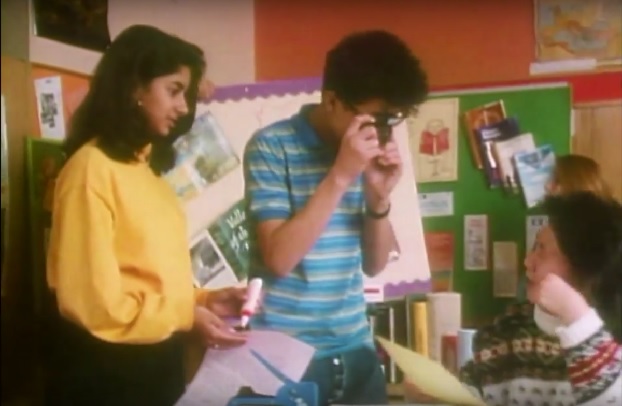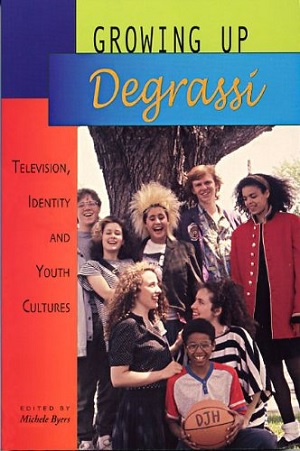I clearly remember my first episode of Degrassi Junior High. I was 10, and it was the summer of 1999. For me, Degrassi was a strange 1980s-era show my sister watched at lunchtime. I just had to wait for it to be over, so I could switch the channel.
One day, I caught the tail-end of an episode, a scene in which the characters (all but one were white), are preparing for a dress rehearsal. One of the characters, Kathleen Mead (portrayed by Rebecca Haines), said something snide about another, Caitlin Ryan (Stacie Mistysn).
In the corner, there’s a brown girl helping Kathleen into her costume. Kathleen appears to be speaking to the brown girl, but she doesn’t respond. Rick Munro (Craig Driscoll) chimes in instead and soon our heroine, Caitlin appears. The brown girl appears to be engaged — she’s listening and observing, but still doesn’t say anything.
I was floored. Who was the brown girl? The credits roll. I find out she has one name: Jyoti, and she’s played by Sabrina Dias.
1980s Canadian Multiculturalism
From The Kids of Degrassi Street in 1979 to Degrassi Junior High to the still-running Degrassi: The Next Generation, the Canadian TV series has a dedicated fanbase around the world. Degrassi Junior High was set in late 1980s Toronto, and it attempted to make diversity visible on screen.
For the most part though, the visibility was the “decoration” of students of color who were a part of the show’s aesthetic and how Degrassi fulfilled the multicultural broadcasting policy. The fact that characters like Jyoti were so far in the background was perhaps indicative of who was in the writer’s room.
“They couldn’t write about her. The visibility part was all that they could get to and that was their success,” says assistant professor Nafissa Thompson-Spires. In her dissertation, “Thank Canada: Locating the Canadian Presence in US Youth Television (2009), Thompson-Spires examined the effects of official multicultural policy on Canadian TV. In Canada, the Broadcasting Act’s “recognition of multiculturalism is largely responsible for the diversity that appears on camera and behind the scenes.” As Thompson-Spires notes, however, the Act does not specify how multiculturalism should be represented.
Degrassi Junior High & Depicting Diversity
Truthfully, Degrassi Junior High probably did a good job depicting 1980’s Toronto diversity. The large ensemble cast was unique to Degrassi. While other teen series tend to focus on a small group of friends, Degrassi had several central characters, which allowed them to develop multiple storylines and explore taboo topics, from a youth perspective.
Most of Degrassi’s background characters had names and were consistently seen as hall walkers throughout the series. One would assume perhaps they had identities too. When I re-watched the series, I realized many of these background characters, like Jyoti, were students of color.
Jyoti was typically found in a group of multicultural friends — she was usually silent on screen and had three or four lines throughout the whole series. In each one of her appearances, I wanted her to say something, to reveal something about herself.
The act of naming background characters like Jyoti underscored the feeling that Degrassi was a real school — that maybe, one day, their stories would unfold. A powerful moment is when you hear their names said aloud, claiming space in the narrative.
In “Stage Fright,” Jyoti is seen at Susie Rivera’s sleepover. When Caitlin has a seizure, the girls panic and Susie yells: “It looks like epilepsy — my aunt has it! Jyoti: go get mom!” This naming of Jyoti and saying her name reaffirmed her existence to me. She was a part of the group — she was named, and so she was included.

Katie A., the creator of @broomheadz, a Degrassi-themed Instagram account chronologizing 1980s fashion, provides an online space focusing on these background characters, assessing their clothing choices and deliberating who they might be.
She says: “I became interested in the background characters after I realized that these kids are not just disposable extras — they are always there, even if they don’t have lines. In a way, it’s bittersweet because each of these background kids could have had their own stories. There’s an air of mystery and potential to each of them which just adds to the intrigue.”
As Katie A. asserts, these characters are recognizable to the viewer. In the background, we see Jyoti commiserating with Vivian Wong (Colleen Lam), while in the foreground, Caitlin is crusading for another cause.
With the background characters, the viewer is left without a story-line or a way to empathize. Some viewers may keep the background characters at the periphery of their Degrassi experience, but some may attempt to fill the narrative gap.
A Look Back At Some Degrassi Junior High’s Characters Of Color
Degrassi Junior High offers interesting insight into a mostly pre-gentrified late-1980s urban Toronto. The characters come from various class backgrounds. They live in different kinds of housing and have all types of family configurations and living situations. These aesthetic clues remain in the narrative’s background but offer a strong sense of place for its viewers.
Degrassi casting mostly reflected the ethnic diversity of the area. There were four second-generation characters of Greek descent — perhaps homage to nearby Greektown. All four were developed with storylines at some point throughout Degrassi.
Yick Yu’s character (Siluck Saysanasi) also connects to Toronto immigration history. In the “Smokescreen” episode, Yick offers insight into his background as a Laotian refugee — perhaps a nod to East Chinatown, where many East Asian refugees settled in the 1970s.
Yick’s character was able to transcend being a “token Asian” — no small feat for a 1980s production. Yick started at Degrassi as an awkward nerd with his best pal Arthur and later grew into a “bad boy” — hanging out with known druggie Luke, smoking on school property, and stealing girlfriends.
Lucy Fernandez (Anais Granofsky) was probably Degrassi’s only fully developed Black character who had multiple storylines. Fashionable Lucy was a wealthy former New Yorker who threw parent-less parties and aspired to be a filmmaker. She also deals with shoplifting, a creepy teacher and a series of dumb boyfriends.
Degrassi’s only storyline about racism, “Black and White,” featured ‘BLT’ Thomas (who is Black and portrayed by Dayo Ade) and Michelle Accette (who is white, played by Maureen McKay) navigating an interracial relationship, much to the chagrin of Michelle’s racist parents. Their relationship primarily centers around Michelle’s experiences (e.g., dealing with her parents’ separation, moving out of father’s home).
Reimagining Jyoti
Like many first and second-generation Canadians, I spent a lot of my childhood getting lost in the world of fiction, hoping maybe to catch a glimpse of someone like me. Degrassi Junior High was one of those shows that allowed me to reflect on the existence of brown kids in a Canadian classroom. Not seeing myself on TV really made me question my self-worth and the possibilities of who I could be even though I went to a school where most students were non-white and difference was at the forefront of our daily lives.
Much like Hari Kondabalu’s search for closure in The Problem with Apu, I need to understand who Jyoti might have been. The presence of Jyoti was an “almost” for me. She was given visibility in the classroom, but she was not given a voice.
To retroactively reimagine Jyoti, I would distinctly mark her cultural background — she’s a second-generation Guyanese girl. Jyoti Ramnarine is also queer. Unlike Caitlin’s short lesbian story arc, Jyoti would explore her queer identity throughout high school and perhaps have a relationship with Susie (in my re-imagining Susie stays at Degrassi and is also queer). Jyoti’s passion is music and she forms a new wave band with her best buds, Susie and Vivian. The band is definitely better than The Zit Remedy.
I wonder about the identity markers I give Jyoti. With Degrassi’s large ensemble cast and limited story arc space, is it possible for Jyoti (or any non-white, non-straight character) to meaningfully explore and unpack their identities without being performative? One of the risks is Jyoti being “the only.” In my reimagining, Jyoti’s identities might prescribe only one way of being queer and Guyanese for all of 1980s North American TV — a large and complicated task to rest on one teenage actor.
Other ways to reimagine Jyoti involve switching her into the role of a major character. A student of color can play these characters and still be relatable. Their characters and storylines would remain the same — except now, Jyoti is the outspoken activist who dates Joey or the school president with a disastrous dating record.
Decentering Whiteness & Including Characters of Color
There were only two options for me to see myself on TV: Apu from The Simpsons, and Jyoti from Degrassi. Apu was hypervisible as a stereotype of an Indian man, while Jyoti was silenced and placed in the background with no narrative. What this said to young brown people like me is that our stories are not worth telling — that our identity can only be tied to a stereotype or being the white character’s best friend.
Illustrator and author Christopher Myers wrote about “The Apartheid of Children’s Literature” in the New York Times, speaking to the importance of children and youth recognizing themselves in fiction and the effects on them when this is lacking:
One is a gap in the much-written-about sense of self-love that comes from recognizing oneself in a text, from the understanding that your life and lives of people like you are worthy of being told, thought about, discussed and even celebrated.
Mitra Sen, who worked as an assistant director on Degrassi Junior High, notes the perception of South Asians in 1980s Toronto: “There were such negative images growing up. Not many people knew about South Asian cultures at the time and there was this denying of heritage because you want to fit in and didn’t take pride in where you came from.”
Racism against South Asians also became physically violent, even in Toronto. The late 1970s and early 1980s saw an increase of racially-motivated attacks in public spaces — a phenomenon known as “Paki bashing,” in the UK and Canada.
Scholar Michele Byers wonders if Degrassi was a text “dependent on whiteness.” The characters in the foreground who are talking to the audience and sharing their stories are mostly white. The implication that whiteness is the norm means the erasure and silencing of background characters, where much of the visible difference exists.
They all grow up in front of us — Jyoti, Vivian, Joy, Mahmoud — and there’s a sense of immediacy with the audience, who, like myself, attempt to construct identities for these characters. “There’s a labor for the audience to work to build that narrative of things unsaid,” says Byers.
Degrassi, still going strong and in 2017, has been known to provide more space in the foreground these days for more kinds of well-developed characters. Brown comedians like Superwoman and Jus Reign have used YouTube as a platform to write their own stories and skits and share them with a growing, increasingly diverse South Asian diaspora. Web series Brown Girls (created by Fatimah Asghar) centers around the friendship between two women of color — a queer Pakistani-American writer and an African-American musician.
The kind of stories that need to be shared on Degrassi and beyond the show are important too. Thompson-Spires says: “There needs to be a holistic approach to dealing with people of color. It can’t be post-racial or an immigrant narrative. We need both those special stories about race and also the development of the students as real, whole people.”
***
Sunjay Mathuria is a city planner living in Regina, Saskatchewan, which is on Treaty 4 Territory and the traditional lands of the Cree, Ojibwe, Saulteaux, Dakota, Nakota, Lakota and the Métis Nation.













